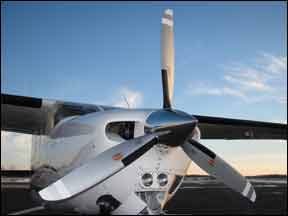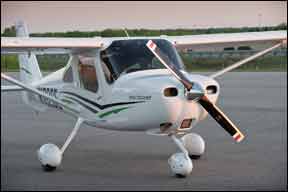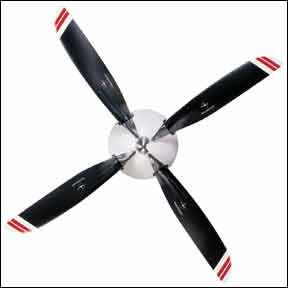Coded into the DNA of every aircraft owner is a grim acceptance that engine overhauls are a fact of life. But prop overhauls and replacements tend to be last-minute, kicking-and-screaming add-ons and with costs up and flight hours down, there are probably more substandard-if not dangerous-props in the field than ever. At least a couple of prop shops weve talked to report that the overhaul business is down, suggesting owners are stretching prop TBOs more than they used to. Thats bad. But the good news is that the competition in the new prop market is hotter than ever and getting even hotter, thanks to MT-Propellers aggressive push into both the OEM and STC replacement markets. This has forced the established manufacturers, Hartzell and McCauley, to respond in kind, although those two companies don’t agree on where the market will move in terms of materials choices. But at least McCauley believes that long-term-at least five to 10 years-the cost of composite props will become competitive with metal props and ultimately result in lower direct operating costs for owners because composite props can be easily renewed through more overhaul cycles.
No Magic Bullet
But the overriding reality is that the old guys working with slide rules during the 1940s largely nailed down a good understanding of prop efficiency. Since then, the industry has made what can best be described as incremental gains in prop efficiency due to more sophisticated profiles and, more important, computer-aided manufacturing.
“The aero guys can work magic if they have something to play with, but if its a good design to begin with, its hard to improve that. Youre talking about playing with the margins,” says Hartzells Mike Disbrow. Even with sophisticated CAD-CAM and computer modeling, a prop is still just a way to move air to make thrust.
But what about the fancy scimitar profiles were seeing in airplanes like the Cirrus SR22 and as replacement props? Mostly cosmetic, says McCauleys Peter Wilkinson. And that applies to three-blade replacements for two-blade applications as well.
“People like to put three-blade propellers on an airplane that would be better with a two-blade because they like the way it looks on the ramp,” says Wilkinson, but none of the manufacturers make significant claims in cruise performance for a three-blade over a two-blade. Theyre happy to just keep the performance comparable.
But thats not to say three-blade or multi-blade props don’t deliver some advantages over two-blade versions. Climb performance can be better with a three-blade, although it isn’t always, and takeoff runs can be shortened. In some applications, the prop blades are shorter, improving ground clearance for back-country operations. M-T Propellers David Noad told us that if the aircraft has the available power, a three-, four- or even five-blade prop can reduce takeoff roll by as much as 15 percent, and it has the data to prove it. When M-T started making its composite-clad props for the aerobatic market, few thought these designs would ever find application in high horsepower aircraft, especially turboprops. But M-T did and has moved aggressively to develop props for such high-performance aircraft as the Socata TBM series, the Jetstream 41 and even the P-51 Mustang, the real one, not scale amateur-built versions. Its generally accepted that multi-blade-three or more-props are best suited for aircraft with the horsepower to absorb that rotational energy, otherwise youre just adding more drag for no particular benefit.
Two vs. Three
Ten years ago, there seemed to be a movement afoot for owners to convert two-blade applications to three blades. Part of this was due to favorable pricing Hartzell

was offering, part was due to a more robust market and the rest was because owners succumbed to emotion. Three-blade props just look sexier and if they don’t cost much more than three-blades, why not?
But is the bloom off that rose? Hartzells Disbrow says although it sold a lot of three-blade props, most owners replacing a two-blade props probably stuck with two-blade props.
“Some applications went up to three blades, most stayed two to two,” says Disbrow. “It very much depends on the applications. Generally, the two-blade to three-blade conversions are mostly about improved takeoff and climb performance and a different kind of noise signature. Most people seem to say they sound better because you get a frequency shift when you go from two to three blades. In some cases, there are ground clearance additions, but not all,” he adds.
At M-T, Dave Noad offers almost the same advice for an owner confronting an overhaulable two-blade prop and considering a three-blade replacement. “Of course, were happy to sell you a new three blade, but in terms of cost, youre probably better off having the overhaul done on your two blade. Generally speaking, an overhaul is usually slightly under the cost of a new propeller.”
Then again, it depends on what the overhaul will require. If the hub is serviceable and only requires minor reworking, and the blades are reusable, a typical two-blade overhaul will cost between $2000 and $3000. But it goes up from there.
“A hub and one blade is definitely a new prop. But one blade by itself, no, thats not necessarily a new prop. Neither is the hub alone,” says Art Michaud, at Aircraft Propeller Works in Auburndale, Florida, an overhauler.
As noted on the chart, new two-blade props are in the $7000 to $9000 range, variable by model and brand. So if the overhaul is going to cost $5000, is it better to jump up and buy a new one or stick with what youve got. “Its hard to make blanket statements,” says Disbrow. “You have to ask specific questions about specific applications.” And one of those questions has to do with speed.
Some owners complain that their airplanes with two-blade props arent as fast as they once were, sometimes even after an engine and prop overhaul. One reason for this is that as they wear, metal props lose their original profiles and with that goes some efficiency. In highly worn props, this can be noticeable. And that leads to the advantages of composites.
A Sea Change?
M-T started out with composite designs-composite cladding over Beech and

Spruce cores-and hasnt looked back. Having watched M-T make market gains, both McCauley and Hartzell have aggressively pursued composites, too. But they part company on what this means. McCauley thinks aluminum props are on the way out, to be displaced by composites, while Hartzell thinks aluminum and composite will co-exist for the foreseeable future.
As McCauley sees it, metal manufacturing costs and more attractive direct operating costs will drive its conversion to composites.
“From my perspective, its going to composite. And I say that because today, there’s a single source supplier for aluminum forgings and thats Alcoa. We are such a small part of Alcoas demand-and they know that-that they can just keep jacking up the price of forgings year after year. There’s nothing we can do about it,” says Peter Wilkinson.
McCauley has recently invested heavily in composite design and manufacture, producing a novel fixed-pitch composite for the Cessna Skycatcher. Wilkinson says that project wont directly yield marketable products, but it builds a foundation for McCauley that will.
While Hartzells Disbrow believes composites will be more expensive than metal props for the foreseeable future and will thus apply mostly to high-horsepower or high-utilization aircraft, Wilkinson believes McCauley can make them cost neutral.
While were loathe to use the phrase “game changing,” cost-neutral composite props would be attractive because their life cycle costs are much lower.
“Just to give you an example, on a Cessna 208, you will typically get two overhauls on a metal propeller. You grind it down on the first overhaul, you grind it on the second, but it probably wont make the third overhaul,” says Wilkinson. “After that, you have to put a new blade set in. With a composite, you’ll typically get 30,000 to 40,000 hours, so the life cycle cost should be significantly less,” he adds.
There’s also a performance kick, since composites are generally lighter than equivalent metal props, and they don’t suffer in-service loss of efficiency because the blades don’t need to be reshaped. The metal leading edges can simply be replaced and any dings or damage repaired with epoxy or other materials in the field, without requiring special tools or equipment.
Says M-Ts Noad, “The beauty of composite propellers is that you can do a field repair very quickly and very easily. Clean it, put a small patch in there with good quality epoxy, sand it, paint it and youre good to go. You havent lost any of the profile of the blade. Its no problem at all for any A&P to do.”

At Hartzell, the market view is a little less broad based. Disbrow thinks that composites will make inroads in those applications where weight matters or where long-term operating costs are decisive. That doesnt necessarily describe the owner of a Bonanza or a Cardinal.
Recommendations
The prop market has shifted substantially since we last examined it. Five years ago, M-T was a boutique maker servicing the experimental and LSA markets. Now, as Hartzell and McCauley are painfully noticing, its a player worth paying attention to.
As our chart on page 5 shows, prices and applications have become intensely competitive in the prop market. Between the three manufacturers, just about every conceivable application is covered and although there are significant areas of overlap, not every application is overlapped by all three.
When considering an overhaul against a new prop, we think you need to construct a spreadsheet and consider the cost of the overhaul against new. Its up to you to decide what cost Delta is worth new vs. the overhaul. Our view is that if the difference is within $2000, a new prop is a good value, especially if youre going to keep the airplane for awhile.
Two blade versus three? Thats easy. If speed is paramount, the two-blade prop will almost always be a better choice. But if ramp appeal and better takeoff and climb performance are goals, three-blade props are worth a look. For some applications, the manufacturers have two-to-three-blade comparative data, and thats worth asking for.
Composite versus metal is more difficult. As Hartzell points out, its composite props are considerably more expensive than metal and recommended only for applications for which the economies make sense. McCauley plans to be competitive in this field, but it isn’t yet, so that leaves M-T.
We think the same reasoning applies as that which Hartzell uses. M-T has a respectable catalog, but its not as large as either McCauleys or Hartzells. But the company is adding at least five STCs a year-thats a pretty good clip. But the M-T props are generally more expensive than equivalent metal, so unless your core prop is totally trashed, an overhaul may be more economical. The long-term operating costs of an M-T prop may pencil out on paper, but that doesnt mean it will work that way in the field.
We recommend building these numbers into your speadsheet, including the direct cost per hour based on the manufacturers recommended TBO. Most props are now six years on the calendar and between 1800 and 2400 hours. But get those numbers before buying and plug them into your comparison.


